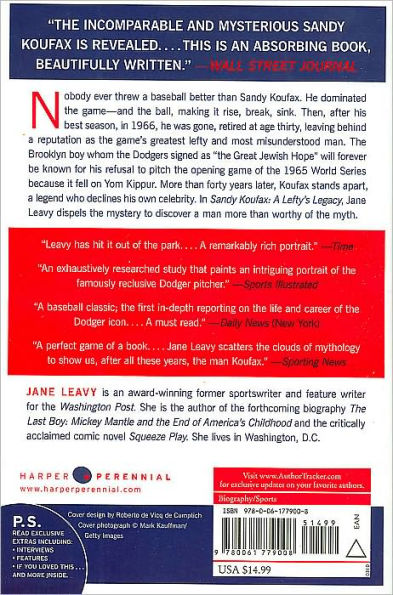No immortal in the history of baseball retired so young, so well, or so completely as Sandy Koufax. After compiling a remarkable record from 1962 to 1966 that saw him lead the National League in ERA all five years, win three Cy Young awards, and pitch four no-hitters including a perfect game, Koufax essentially disappeared. Save for his induction into the Hall of Fame and occasional appearances at the Dodgers training camp, Koufax has remained unavailable, unassailable, and unsullied, in the process becoming much more than just the best pitcher of his generation. He is the Jewish boy from Brooklyn, who refused to pitch the opening game of the 1965 World Series on Yom Kippur, defining himself as a man who placed faith over fame. This act made him the standard to which Jewish parents still hold their children. Except for his autobiography (published in 1966), Koufax has resolutely avoided talking about himself. But through sheer doggedness that even Koufax came to marvel at, Jane Leavy was able to gain his trust to the point where they talked regularly over the three years Leavy reported her book. With Koufax′s blessing, Leavy interviewed nearly every one of his former teammates, opponents, and friends, and emerged with a portrait of the artist that is as thorough and stylish as was his command on the pitching mound.
No immortal in the history of baseball retired so young, so well, or so completely as Sandy Koufax. After compiling a remarkable record from 1962 to 1966 that saw him lead the National League in ERA all five years, win three Cy Young awards, and pitch four no-hitters including a perfect game, Koufax essentially disappeared. Save for his induction into the Hall of Fame and occasional appearances at the Dodgers training camp, Koufax has remained unavailable, unassailable, and unsullied, in the process becoming much more than just the best pitcher of his generation. He is the Jewish boy from Brooklyn, who refused to pitch the opening game of the 1965 World Series on Yom Kippur, defining himself as a man who placed faith over fame. This act made him the standard to which Jewish parents still hold their children. Except for his autobiography (published in 1966), Koufax has resolutely avoided talking about himself. But through sheer doggedness that even Koufax came to marvel at, Jane Leavy was able to gain his trust to the point where they talked regularly over the three years Leavy reported her book. With Koufax′s blessing, Leavy interviewed nearly every one of his former teammates, opponents, and friends, and emerged with a portrait of the artist that is as thorough and stylish as was his command on the pitching mound.

Sandy Koufax: A Lefty's Legacy
288
Sandy Koufax: A Lefty's Legacy
288
Product Details
| ISBN-13: | 9780061779008 |
|---|---|
| Publisher: | HarperCollins Publishers |
| Publication date: | 03/16/2010 |
| Series: | P.S. Series |
| Pages: | 288 |
| Sales rank: | 26,353 |
| Product dimensions: | 5.30(w) x 7.90(h) x 0.90(d) |
About the Author
Customer Reviews
Explore More Items
At first glance, Three Lives seems to be three straightforward portraits of women living in the early twentieth century. “The Good Anna” describes an exacting German house servant;
Michael Lewis, whose LIAR'S POKER foreshadowed events at
There was a turning point in Michael Lewis's life, in a baseball game when he was fourteen years old. The irascible and often
Michael Lewis is a master at dissecting the absurd: after skewering Wall Street in his national bestseller Liar's Poker, he packed his mighty pen and set out on the 1996 campaign trail. As he
When Michael Lewis first met him, Sam Bankman-Fried was the world's youngest billionaire and crypto's Gatsby. CEOs, celebrities, and leaders of small countries all vied for his time and cash after he



